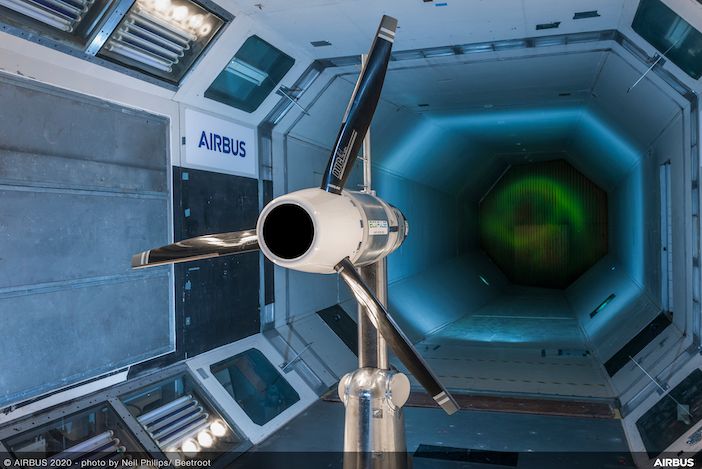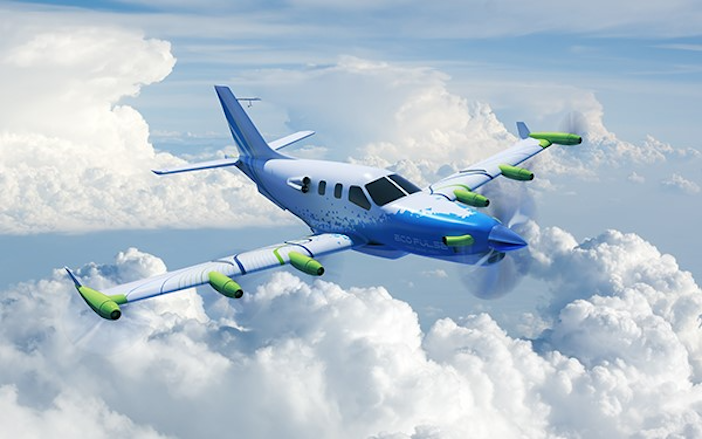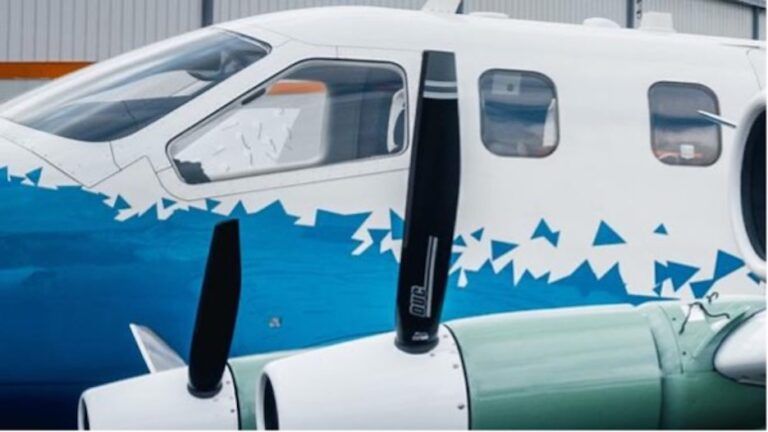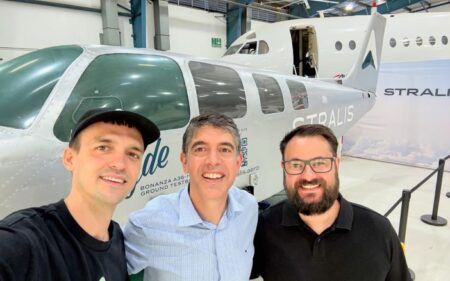Airbus is to reveal its EcoPulse hybrid-electric aircraft for the first time in public next week, ahead of the technology demonstrator’s first flight later this year.
The EcoPulse is a Daher TBM light aircraft modified with a hybrid-electric powertrain and six electrically-driven propellers along the wing thatis being developed by Airbus, Daher and Safran.
The French Government and EcoPulse project started in 2019 and aims to demonstrate the technology for distributed electric propulsion (DEP) and evaluate its advantages. This includes considering the onboard overall energy efficiency fuel reduction and high-voltage electrical propulsion and battery in terms of their potential for integration on future aircraft.
After the development and integration of the high-voltage battery into the test aircraft last year the project team has been preparing the demonstrator’s final aerodynamic and systems configuration. A particular focus has been the six electrically driven propellers, which are mounted on the wing’s leading edge and the novel on-board distribution electric propulsion (DEP) and flight control systems.
Preliminary aerodynamic testing
Since the start of this year Daher, the TBM aircraft’s manufacturer, has conducted test flights at its development base in Tarbes, France, powered by the turboprop engine in the nose and Safran-supplied electrically-driven propellers unpowered. The flight test program took place progressively, starting with two propellers, then four, then with all six attached.
Each of the units, which Airbus is calling an “e-Propeller” features a three-bladed propeller supplied by DUC Propellers attached to a Safran 50kW ENGINeUS electric motor housed in a pod immediately behind.
The preliminary flight testing has allowed the test pilots to focus their attention on the aerodynamics, the added inertia, and other effects of the pods and their propellers on the platform’s handling characteristics. Airbus said that the flight tests have been an important step to a distributed hybrid-electric flight later this year, which will use the six activated wing-mounted e-Propellers.

Demonstrating DEP in flight
DEP is when a single independent electrical power source, or a mix of them power several engines distributed throughout the aircraft.
EcoPulse features a high-voltage 800VDC battery supplied by Airbus to power six SmartMotors with a 100kW turbogenerator also onboard provided by Safran. The turbogenerator contains a compact gas turbine coupled to an electrical generator.
Airbus’ said the main challenge for developing the battery was to make it lightweight, compact, with very high power and energy density, as well as being compliant with environmental regulations and safe.
At the heart of the DEP architecture is a Power Distribution and Rectifier Unit (PDRU) which is responsible for protecting the high-voltage network and for distributing the available electrical power, as well as high-voltage power harnesses, both developed by Safran.
DEP also allows for differential control of the thrust. The SmartMotors will be controlled individually by the Flight Control Computer (FCC), developed by Airbus, to perform lateral control. This will reduce reliance on a large physical tail rudder and/or ailerons, potentially reducing weight and drag, as well as speed control tasks.

Meanwhile, Daher has modified the cockpit so the pilot can engage the various DEP modes such as torque control or speed control via a panel and then fly the aircraft using throttle for power, comprising of simply left and right throttle levers – one for each wing, and a sidestick to control the aircraft’s overall direction and trajectory.
According to Airbus, pilots will not have to think about what each e-Propeller and/or flight control surface is doing in real-time – either in isolation or in combination – since that aspect is taken care of by the FCC logic.
Another useful feature is that, unlike traditional gas turbine aero-engines the angular displacement of each e-Propeller’s rotor can be precisely monitored and governed digitally down to one single degree. This enables each propeller to be automatically synchro-phased relative to the adjacent ones to minimize noise and vibration during flight. This aspect will be explored in the forthcoming flight test campaign with the DEP activated.
Paris Air Show 2023
Following the latest flight testing with the six unpowered pods, the teams have been preparing the full installation, activation and ground testing of the high-voltage power train, including the turbogenerator, battery and the operational e-Propellers.
Airbus will also show the EcoPulse demonstrator at its static “Paris Air Lab stand”. The demonstrator is expected to make its flight with DEP fully engaged “later this year”.
Modified from the original Airbus story first published here.





